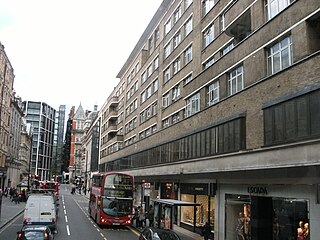
Harley Street is a street in Marylebone, Central London, which has been noted since the 19th century for its large number of private specialists in medicine and surgery. It was named after Edward Harley, 2nd Earl of Oxford and Earl Mortimer.

The Red House is a Queen Anne style house built around 1710 opposite the intersection of Norfolk Road and High Street in Buntingford, Hertfordshire, England. It was inhabited by artist and stage designer Claud Lovat Fraser, who designed the Buntingford war memorial and other aspects of the town. The building was used by estate agency Churchills, but currently appears unoccupied. It is a Grade II Listed Building.

Jermyn Street is a one-way street in the St James's area of the City of Westminster in London, England. It is to the south of, parallel, and adjacent to Piccadilly. Jermyn Street is known as a street for gentlemen's-clothing retailers.

Sloane Street is a major London street in the Royal Borough of Kensington and Chelsea which runs north to south, from Knightsbridge to Sloane Square, crossing Pont Street about halfway along. Sloane Street takes its name from Sir Hans Sloane, who purchased the surrounding area in 1712. Many of the properties in the street still belong to his descendants, the Earls Cadogan, via their company Cadogan Estates.

Marylebone Gardens or Marybone Gardens was a London pleasure garden sited in the grounds of the old manor house of Marylebone and frequented from the mid-17th century, when Marylebone was a village separated from London by fields and market gardens, to the third quarter of the 18th century.

Cavendish Square is a public garden square in Marylebone in the West End of London. It has a double-helix underground commercial car park. Its northern road forms ends of four streets: of Wigmore Street that runs to Portman Square in the much larger Portman Estate to the west; of Harley Street which runs an alike distance; of Chandos Street which runs for one block and; of Cavendish Place which runs the same. The south side itself is modern: the rear façade and accesses to a flagship department store and office block. On the ground floors facing are Comptoir Libanais, Royal Bank of Scotland and Pret a Manger premises.

The Cranbrook Estate is a housing estate in Bethnal Green, London, England. It is located next to Roman Road and is based around a figure of eight street called Mace Street. The estate was designed by Francis Skinner, Douglas Bailey and an elder mentor, the Soviet émigré Berthold Lubetkin.

Portland Place is a street in the Marylebone district of central London. Named after the Third Duke of Portland, the unusually wide street is home to BBC Broadcasting House, the Chinese and Polish embassies, the Royal Institute of British Architects and numerous residential mansion blocks.

Camberwell Grove is a residential street in Camberwell, London, England, in the Borough of Southwark. It follows the line of a grove of trees, hence the name. The street once led from a Tudor manor house south to the top of a hill, which afforded a view of the City of London, approximately three miles to the north. Today, the grove is part of Camberwell Grove Conservation area.

Burlington Gardens is a street in central London, on land that was once part of the Burlington Estate.

The Fox and Anchor is a Grade II listed public house at 115 Charterhouse Street, Farringdon, London.

The Howard de Walden Estate is a property estate in Marylebone, London, owned by the Howard de Walden family. As of 2020 the estate was reported to be worth £4.7 billion.

Weymouth Street lies in the Marylebone district of the City of Westminster and connects Marylebone High Street with Great Portland Street. The area was developed in the late 18th century by Henrietta Cavendish Holles and her husband Edward Harley, 2nd Earl of Oxford. This part of Marylebone originally belonged to the Manor of Tyburn which existed at the time of the Domesday Book (1086).

Nottingham Street is a street in the City of Westminster, London, that runs from Marylebone High Street in the east to Luxborough Street in the west. It is crossed by Nottingham Place. Bingham Place and Oldbury Place join it on the north side.

New Cavendish Street is a street in the City of Westminster, London, that runs from Marylebone High Street in the west to Cleveland Street in the east. The street was built in 1775 and named after the Cavendish family, who were related to the ground landlords, the Dukes of Portland.

110 and 112 Harley Street are grade II listed terraced town houses in Harley Street, in the City of Westminster, London. The houses were of the "first rate" class, built around 1777 as part of the Portland Estate, probably by John White and the plasterer Thomas Collins who were associated with Sir William Chambers.

54 Welbeck Street is a grade II listed town house in Welbeck Street, in the City of Westminster, London. The house is dated 1896 and in free style pink terracotta "Jacobethan".

Bulstrode Street is a street in Marylebone in the City of Westminster that runs from Welbeck Street in the east to Thayer Street in the west. It is crossed only by Marylebone Lane.

John Prince's Street, also Princes Street, is a street in Marylebone in the City of Westminster in central London that runs from Margaret Street in the north to Oxford Street in the south. It is joined on its eastern side by Great Castle Street.

Chesterfield Street is a "virtually intact" Georgian street in London's Mayfair district. Several of the buildings are Grade II listed on the National Heritage List for England.




















